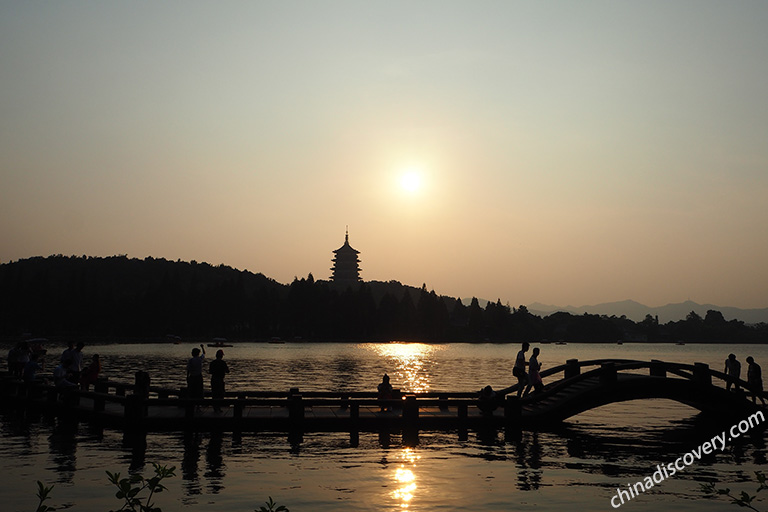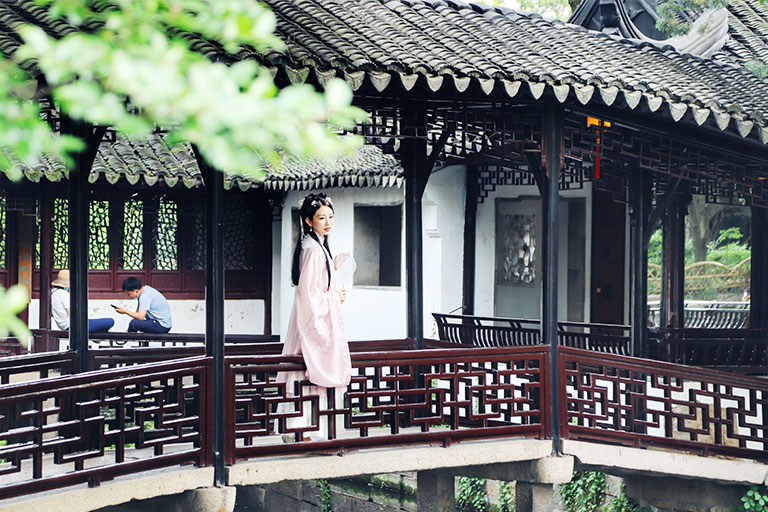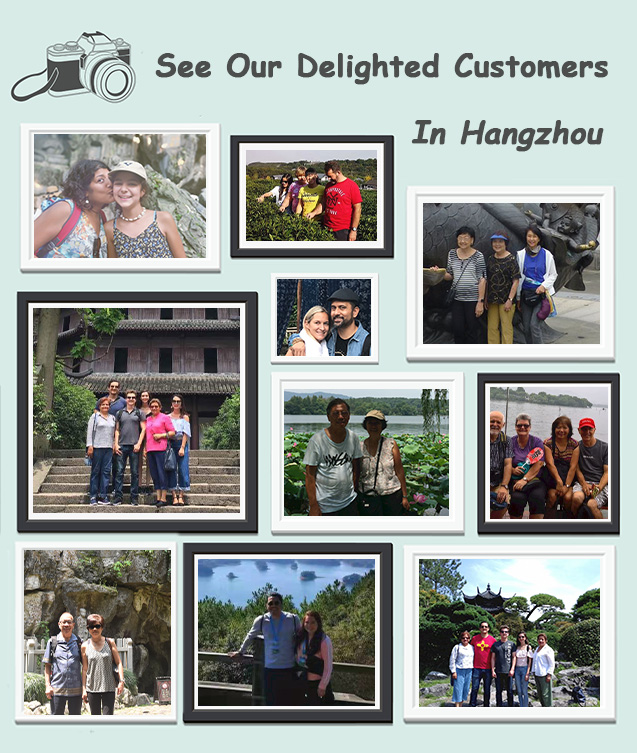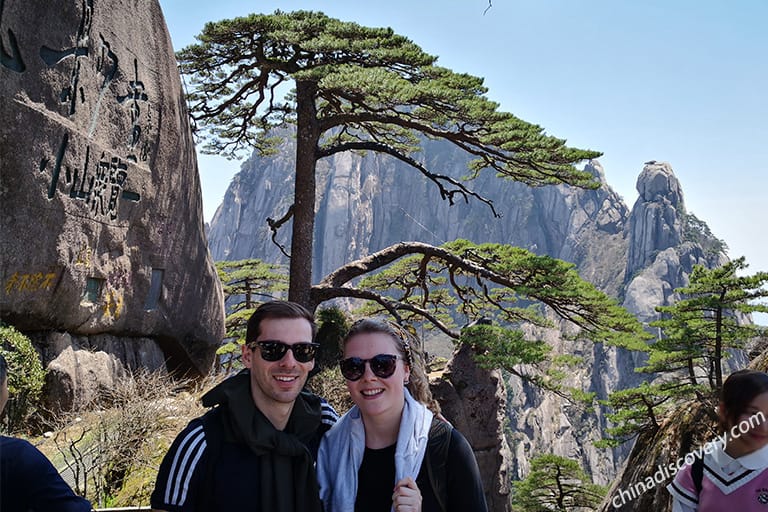Brief Introduction about China National Silk Museum
Newly reopened in July 2016, China National Silk Museum (short for CNSM), located on the south side of West Lake in Hangzhou, is not only the first state-level specialized silk museum in China, but also the largest silk museum in the world at present.
China National Silk Museum displays approximately 5000 years of silk history and culture, regarded as an educational and amazing window for travelers to gain a better understanding about Chinese silk and the Silk Road and develop a new respect and appreciation for Chinese and Western silk art and fashion.
Besides, China National Silk Museum has very elegant environment - graceful architecture stretching out on the green grasslands, different kinds of flowers blooming, water gurgling, and birds singing...bringing you a fresh and comfortable visit while you learn about silk creation.
 Silkworm Reeling & Sericulture Presentation
Silkworm Reeling & Sericulture Presentation
Featured China National Silk Museum Exhibition Halls & Highlights
Covered about 42,286 sq.m.,China National Silk Museum consists of six main parts - “The Story of Chinese Silk”, “Sericulture and Silk Craftsmanship in China”, “An Evolution of Fashion: Chinese Costume from 1920s to 2010s”, “From Rural to Urban: 400 Years of Western Fashion”, “Textile Conservation Gallery” and “Xinyou Archive Center”.
Better Know the History of Chinese Silk & the Silk Road
China, the home of silk, is the earliest country to raise silkworms and weave silk. It was known to the ancient Greeks and Romans as “seres” (丝国). In this exhibition hall, “The Way of Chinese Silk: Silk History and the Silk Road”, travelers can know Chinese Silk vividly through 5000 years' history and spread through the Silk Road. On the second and third floors, it displays precious materials of different times from the prehistoric era (5000 years ago) to the Ming (1368~1662) and Qing (1636~1912) Dynasties.
Have a Basic Understanding of Sericulture and Silk Craftsmanship
Sericulture and silk technology originated in China have since served as a cultural symbol of the Chinese nation. “Sericulture and Silk Craftsmanship in China” was awarded a place on the "Representative List of the Intangible Cultural Heritage of Humanity" by UNESCO on September 28, 2009. This exhibition displays every aspect of sericulture and silk craftsmanship, including mulberry cultivation, silkworm breeding and silk reeling, dyeing, weaving and the relevant customs.
 Dragon Robes in Qing Dynasties (1636~1912)
Dragon Robes in Qing Dynasties (1636~1912)
 All Kinds of Loom for Silk Weaving
All Kinds of Loom for Silk Weaving
Witness the Evolution of Fashion from 1920s to 2010s
This “An Evolution of Fashion: Chinese Costumes from 1920s to 2010s” exhibition hall is like a huge wardrobe of any Chinese woman. Travelers can view exquisite clothes from the 1920s to the 2010s, ranging from Qi-pao which recognized as the most representative of Chinese women's costumes and presented the graceful shape and unique charms of Chinese women, to the Chinese tunic suit, which is traditionally known as Zhongshan suit, to China's fashion design to integrate with global trends… In this exhibition, you can have a vivid view of the process of change in Chinese fashion throughout the century to present achievements of Chinese fashion.
Appreciate 400 Years of Western Fashion
In the exhibition hall “From Rural to Urban: 400 Years of Western Fashion”, travelers can appreciate major fashion in the Western world during the past four hundred years. The first hall of the exhibition concentrates on European fashion from 1600 to 1800. In the second half of the exhibition, starting in the second half of the 20th century. You can view 17th century Baroque Dress, 18th century Robe Volante, Polish Dress, PANEA Dress and 19th century Jane Austen Dress, Bustle, etc. In the 20th century, there were many costumes from excellent designers, like Jeanne Lanvin, Gabrielle Bonheur Chanel, Christian Dior, Cristobal Balenciaga, Hubert DeGivenchy, Pierre Balmain, etc. Besides the dresses, you can take a glance at the change of shoes, handbags, jewelry, and make-up utensils.
 Qi-pao, the most representative of Chinese women's costumes
Qi-pao, the most representative of Chinese women's costumes
 19th century Western Fashion
19th century Western Fashion
Pay a Visit to Textile Conservation Gallery
The Textile Conservation Gallery is the demonstrative application base of Innovation Alliance in the National Cultural Relics Conservation Scientific and Technological Area (Zhejiang Province). In this gallery, travelers can not only have a look at the whole restoration of cultural textiles, but also enjoy the relics after restoration.
Take a Glance at Xinyou Archive Center
The Xinyou Archive Center is a textile information center named after Zhu Xinyu and Jiang Youlong, two important predecessors in the textile industry. Travelers can learn much knowledge from samples of modern fabrics, precious personnel archives, historical newspapers, books and audio materials at home and abroad concerning silkworm breeding and silk reeling, the history of silk, dyeing techniques, the history of garments, textile archaeology and the Silk Road.
 Silk Restoration at China National Silk Museum
Silk Restoration at China National Silk Museum
In-depth Knowledge about Chinese Silk History
- The Prehistoric Era - the Origins of Sericulture. The excavated remnants of sericulture discovered in archaeological sites along the Yellow River have shown concrete evidence that, as early as 5000 years ago, people living there had accomplished the domestication of the wild silkworm and the invention of tools for reeling, spinning and weaving of silk fivers after a long, slow and arduous process of experimentation and discovery.
- The Period of Warring States, Qin and Han Dynasty - Classical Silk Manufacture in China. During these seven centuries, unprecedented advances took place in sericulture technology and scale, and the importance of silk in China grew significantly. The breeding of silkworms, cultivation of mulberry trees and invention of looms in which foot-operated treadles controlled the warp to allow the insertion of weft threads, as well as patterning looms in which “pre-programmed” patterns could be reproduced, coalesced in the classical system of Chinese silk production.
- The Period of Wei, Jin, and Southern and Northern Dynasties - A Turn of the Silk Road. During this time, China and Japan had frequent interaction and the Japanese came to Zhejiang and Jiangsu Provinces to purchase some silk and invite craftsmen to Japan to teach craftsmanship.
- The Period of Sui, Tang and the Five Dynasties - Diverse and Inclusive. It has played a key role in the development of Chinese silk. The government set up a specialized institution to manage the quality, standard and style of silk. The silk trade flourished through the Land Silk Road and the Maritime Silk Road and also silk breeding, reeling, weaving skills spread far and wide.
- The Period of Song, Yuan, Liao and Jin Dynasties - Difference between the North and South. For the chaos in the late Song, the silk industry suffered a serious defeat in the north, while it developed quickly in the south. The silk production center was transformed to the Southeast coastal area.
- The Period of the Ming and Qing Dynasties - The Feudal Ritual. In the Ming Dynasty, men wore robes with round collars, right openings and wide sleeves. In the Qing Dynasty, men wore short “Mandarin” jackets over long robes, and Manchu women wore qifu robes and some long enough to reach the ground. During the Ming and Qing Dynasties, Han Chinese women continued to wear traditional tops and skirts. During these periods, not only clothing, but even articles used in daily life by aristocrats and commoners alike were decorated with patterns and motifs signifying good fortune, happiness, longevity, large families and other auspicious concepts. These customs embody the desire for a healthy and happy life, a key element of traditional culture in ancient China.
 Silk Blouse in Taffeta with Tie Dye Pattern (L72cm, W192cm, Northern Dynasties. 386-581 A.D)
Silk Blouse in Taffeta with Tie Dye Pattern (L72cm, W192cm, Northern Dynasties. 386-581 A.D)
 Combination of "Long Sleeves Inside, Short Sleeves Outside" (Ming dynasty 1403-1425 A.D)
Combination of "Long Sleeves Inside, Short Sleeves Outside" (Ming dynasty 1403-1425 A.D)
 Polychrome Embroidered Manchurian Dress (L138cm, W124cm, Qing Dynasty. 18th-19th centuries)
Polychrome Embroidered Manchurian Dress (L138cm, W124cm, Qing Dynasty. 18th-19th centuries)
China National Silk Museum Location & How to Get There
China National Silk Museum is located at Yuhuangshan Road which is on the south side of Hangzhou West Lake, close to Leifeng Pagoda, Changqiao Bridge Park, Colored Port View Fish Garden, Prince Bay Park, etc.
Distance from Main Tourist Spots of Hangzhou:
- about 1.2 kilometers from West Lake
- about 5 km from Lingyin Temple, 30 mins by car
- about 2 kilometers from Su Causeway & Leifeng Pagoda
- about 5.2 kilometers from Broken Bridge & Bai Causeway, 20 mins by car
- about 3 kilometers from Hefang Street
- about 9.5 km from Hangzhou East Railway Station, 40 mins by car
- about 4 km from Hangzhou Railway Station, 15 mins by car
- about 18 km from Hangzhou West Railway Station, 50 mins by car
- about 14.5 km from Hangzhou South Railway Station, 40 mins by car
Get to/off China National Silk Museum
Independent travelers can take a taxi, private vehicle, bus, or bicycle ride to reach China National Silk Museum. Bus No. 12, 31, 42, 87, 124, 133, 271, Y9, West Lake Inner Circular Line, West Lake Outer Circular Line, and more stop at Silk Museum station. If you take a bike to cycle around West Lake and its nearby attractions, you can add China National Silk Museum to your travel list, which takes about 8 minutes from Su Causeway and Leifeng Pagoda Scenic Area to China National Silk Museum. The nearest metro station is Wushan Square Metro Station of Metro Line 7, which is about 2.4km (8 mins by car) away from the museum.
Travel with China Discovery (Recommended):
If you want to get rid of hustle of public transportation and troublesome navigation, it's highly suggested to travel with us China Discovery. As part of our comprehensive tour packages, we offer convenient pick-up & drop-off at airports and train stations, as well as seamless transportation between all scenic spots on your itinerary. Once you book our service, you'll bid farewell to travel-related worries, with a knowledgeable tour guide, satisfactory accommodation and dining and so on. You just need to focus on sightseeing. So, don't hesitate to contact us and let us take care of all your travel needs in China.
 Our Local Private Transfer Service
Our Local Private Transfer Service
Useful China National Silk Museum Travel Tips
1. Opening Hours
Like most museums in Hangzhou, China National Silk Museum opens at 09:00-17:00 on Tuesdays to Sundays, while it closes on Mondays (open as usual on Mondays that fall on national holidays).
2. Appointment
Visitors don't need to make an online reservation and can enter the museum by swiping your valid documents such as ID cards or citizen cards, or through real-name registration.
3. Audio Guide Device
The museum provides free smart guided tours via the official WeChat account, paid audio guides (electronic guiding devices) and paid manual guiding services. For details, please check the official website (https://www.chinasilkmuseum.com/cgjyy/list_6.aspx).
4. Textile Training Experience
China National Silk Museum has set up Textile Training Center which offers the professional courses related to dyeing, weaving, embroidering and plaiting. Travelers can come to “Textile Training Center” to learn weaving techniques in relaxing atmosphere and experience fun of weaving.5. Silk Product Purchase
There is a service center for travelers to take a rest and buy some silk products. All the silk products are guaranteed to be genuine.
 World of Silk Exhibition
World of Silk Exhibition
 Tourist Service Center
Tourist Service Center
How to Plan a Hangzhou Tour
Things to Do in Hangzhou: West Lake, Lingyin Temple, Longjing tea Plantation, Hefang Street, Xixi National Wetland Park, China National Tea Museum, China National Silk Museum…
How to Get to Hangzhou: International flights from Singapore (5 hrs.), Seoul (6.5 hrs.), etc., domestic flights from Guangzhou (2 hrs.), Beijing (2 hrs.), etc., or high speed trains from Shanghai (1~2 hrs.), Suzhou (1.5~3 hrs.), Huangshan (1.5~2 hrs.), etc.
Best Time to Visit Hangzhou: all year around
Usually, visitors spend 2 days around to enjoy a classic Hangzhou tour to visit the West Lake Scenic Area, including the amazing West Lake, Lingyin Temple, Longjing Tea Plantations, etc. If you want an in-depth Hangzhou tour, you can also pay another half day or so to visit Xixi National Wetland Park, one day around to Beijing-Hangzhou Grand Canal, or one day or so to Thousand Islands Lake, etc. Check all Hangzhou Tours >>
☛ 2 Days Essence of Hangzhou Tour
☛ 3 Days Classic Hangzhou Tour Plus Tea Plantation Exploration
Also, you can spend 1 day to take a side trip to the nearby water towns like Wuzhen and Xitang in Jiaxing, 2~3 days to Putuoshan - one of the four sacred Buddhist Mountains in China, or 1 day to the popular Nanxun Old Town in Huzhou. Check more about Zhejiang Tours >>
☛ 3 Days Best Hangzhou Tour with Wuzhen Water Town
Besides, compared with just travelling Hangzhou, most of the visitors prefer to travel the metropolis Shanghai, Suzhou Gardens and Hangzhou Lakes in One Go! Such an amazing tour will take 5~6 days.
☛ 5 Days Shanghai Hangzhou Suzhou Highlights Tour
☛ 3 Days Hangzhou & Suzhou Beauty Tour by High Speed Train
☛ 4 Days Heavenly Hangzhou Suzhou Tour with Zhouzhuang Water Town
Some visitors also ride a high speed train to Huangshan to visit the world-famous Yellow Mountain. A Hangzhou Huangshan tour needs about 5 days around.
☛ 5 Days Yellow Mountain Tour from Hangzhou
Have your preferences? Please feel free to tell us your likes and let our professional travel consultants customize a personal tour for you!
 Hangzhou West Lake Summer Sightseeing
Hangzhou West Lake Summer Sightseeing
 Our Customers visited Meijia Dock Longjing Tea Plantation, Hangzhou
Our Customers visited Meijia Dock Longjing Tea Plantation, Hangzhou
Get Inspired by Real Travel Stories of Our Customers
Since 2012, we China Discovery have helped numerous customers to visit Hangzhou and surroundings. With our fully-inclusive private tour packages, all of our customers enjoyed their trips to the West Lake, Lingyin Temple, etc. Some of them kindly shared their precious photos and stories about their Hangzhou journey, just get inspired now.
"Impression Show is a must see when visiting Hangzhou…" - shared by Nguyen (Read her entire travel story: The Pursuit of Natural Beauty with the Beloved one - 14 Days Beautiful China Exploring Tour)
"This last night in Hangzhou led us to explore a different side of West Lake, vastly changing our erstwhile bland impression of the famed tourist site…" - shared by CS from Singapore (Read her entire travel story: Delightful Journey to Poetic Jiangnan Area)
Besides the wonderful travel stories, many customers who visited Hangzhou with China Discovery also send us their first-hand feedbacks about their trip, feel free to read the Hangzhou Reviews and learn what they say about their experience. If you want to start your Hangzhou tour now, don't hesitate to contact us.
- Essence Hangzhou Tour
- 3 Days Hangzhou Wuzhen
- 3 Days Hangzhou Suzhou
- Shanghai Hangzhou Tour
Hangzhou Tours
- West Lake
- Lingyin Temple
- Longjing Tea Plantations
- Hefang Street
- Hu Qing Yu Tang
- China National Tea Museum
- Xixi National Wetland Park
- Liuhe Pagoda
- Qiantang River Tidal Bore
- Wuzhen Water Town
- Xitang Water Town
- Qiandao Lake
Hangzhou Attractions
- Things to Do
- Attractions
- Get There & Around
- Get to West Lake
- Airport to City
- Hangzhou to Wuzhen
- Xiaoshan Airport
- Hangzhou Train Stations
- Hangzhou High Speed Train
- Hangzhou Metro
- Hangzhou Bus
- West Lake Boat
- Where to Stay
- Hangzhou Hotels
- Hangzhou Weather
- Hangzhou Maps
- Hangzhou Museums
- Hangzhou Nightlife
- Hangzhou Food
- Hangzhou Biking
- 144-Hour Visa-Free Transit
- Hangzhou Travel FAQs & Tips
- How to Plan Hangzhou Tour
- More Hangzhou Travel Guide
Hangzhou Travel Guide
More about Zhejiang Travel Guide
Recommended Hangzhou Tours
Top 3 Hangzhou tours chosen by most customers to explore Hangzhou in the best way. Check the detailed itinerary, or tailor your own trip now with us.

8 Days Shanghai Hangzhou Beijing Highlights Tour by High Speed Train
Shanghai / Hangzhou / Beijing

9 Days Dream Tour to Hangzhou and Yellow Mountain by High Speed Train
Shanghai / Suzhou / Hangzhou / Huangshan

3 Days Hangzhou Suzhou Beauty Tour by High Speed Train
Hangzhou / Suzhou
Start planning your tailor-made holiday to China by contacting one of our specialists. Once inquired, you’ll get a response within 0.5~23.5 hours.
Customize a TripHave a question? Get answers from our travel experts or guests
- Your Question:
- Your Name:
- Your Email:
- Submit

























































